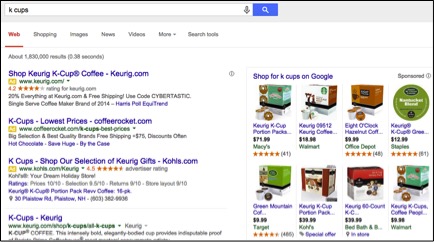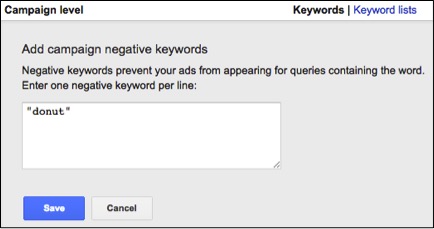One of the features of PPC I love the most is how specific it can be. For example, if a user is searching for “donut shop k cups,” you can tailor your ad to speak to this product while sending the person to a landing page containing “donut shop k cups.” However, not every search is this specific.
A large percentage of searches are root terms, also known as top of funnel terms. In our example above, the root search would simply be “k cups.” A user typing in this query may see general ad results speaking to a large selection or low prices. Below is a screenshot of sample text and shopping ads showing for the root term “k cups.”

These users may not yet know what type of k cups they are looking for, thus are at the top of the funnel. A specific search for “donut shop k cups” indicates that the user is looking for a particular flavor and is further down the funnel. Though it would be ideal to only bid on specific keywords, we would not see account growth without targeting top of funnel terms.
When bidding on top of funnel keywords, certain expectations and strategies need to be put in place. First and foremost, the main goal is to capture broader traffic that will convert. This traffic may be comparison shoppers or users in research mode without a clear understanding of what they want. Inevitably, some poorer quality traffic will come through, but the long-term strategy is to acquire new customers and grow account revenue.
Set Top of Funnel Specific Campaign Goals
Not only are top of funnel keywords general, but they also tend to cost more. According to Google’s Keyword Planner, the suggested bid for “k cups” is $2.15 while “donut shop k cups” is $1.19. That’s almost a dollar more per click you could end up paying on the more general term. If the overall account ROI goal is 400%, chances are the top of funnel campaigns are going to drag this number down.
It makes sense to set different goals for each campaign. Whereas we normally would expect a 400% ROI, perhaps when targeting top of funnel keywords we shoot for 250%. When reporting, these campaigns can be segmented into a different bucket so we know the metrics related to both the general and specific keywords.
It’s also important to consider the lifetime value of a customer. You may be paying more to get the customer in the door and make that initial purchase, but in the long run that user now knows you. In other words, you now have a new customer whom you probably wouldn’t have received otherwise.
Strategically Use Negative Keywords
Depending on match types, specific queries may trigger your general ads. For example, let’s say you have a campaign around donut shop k cups and are bidding on the modified broad match of “+donut shop +k +cups.” In the top of funnel campaign, you are bidding on the modified broad match of “+k +cups.” Theoretically, a search for “donut shop k cups” will yield the specific ad, but it’s possible the keyword “+k +cups” will pick up the query and show the ad, especially if the general term has a higher bid.
In order to avoid the wrong ad showing, negative keywords need to be placed in the top of funnel campaigns. In this case, we would add “donut” as a negative keyword in our general k cup campaign.

We’re explicitly telling the search engines to show our ad from the donut shop k cup campaign rather than the general campaign.
Write Encompassing Ad Copy
If a user is searching for “k cups” we want to highlight our selection. Here is an example of an ad speaking to our wide variety. The ad emphasizes the fifty flavors while also highlighting three of our popular varieties.

It also makes sense to highlight the different flavors directly within the sitelinks. Since we can use callout extensions for our value ads (free shipping, satisfaction guaranteed, etc), our sitelinks can speak to more flavors. We can list our top sellers or some of the more obscure flavors to further emphasize our variety. Either way, sitelinks give us additional space to list more k cup flavors.
Have Remarketing In Place
Remarketing isn’t unique to top of funnel keywords, but it has greater importance when targeting users in research mode. Chances are a user searching for “k cups” will view several sites before making a purchase decision. It’s key to stay in front of these users as they shop around. Both static and dynamic remarketing ads are worthwhile to use.
Conclusion
As much as top of funnel keywords go against our specific targeting strategies, they are crucial for account growth. As long as proper expectations and goals are set, top of funnel keywords will capture new customers and represent necessary expansion.
What other strategies do you use to target top of funnel keywords? Leave your comments below!



